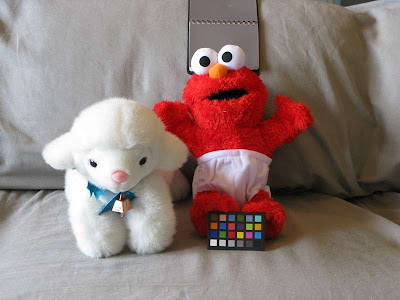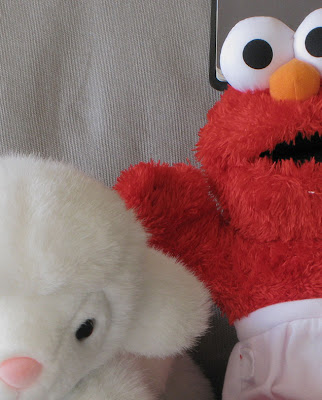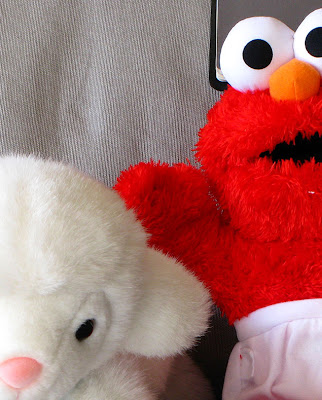
A lot can be learned with a simple setup. The above image of Elmo and Kitty-Cow is a good example. Sure, if you’d happened upon this scene, you’d probably fire away on full auto (and get a flash photo) but a more methodical process can be very educational. In particular, I wanted to try my hand at fine tuning the in-camera JPEG settings. Besides, this was a chance to use the new cable release as well (worked great).
The above scene was lit with mixed lighting: sunlight through a window at left plus direct overhead tungsten. What is the correct white balance setting? I tossed in a old gray card for reference.
What about exposure? Light meters assume neutral gray but a Kitty-Cow is white (there are black kitty-cows but, technically, these are bear-dogs). The couch is nearly neutral and Elmo is, of course, quite colorful. I often begin a shoot in aperture mode (Av) and use the camera as a light meter. With the G9 at ISO 100, Av mode at f4.8, zoomed out all the way and set for spot metering, the “correct” exposure varied a lot as I panned over the scene. Kitty-Cow wanted 1/15 second; Elmo 1/4; the couch 1/6 and the gray card 1/5. So this is a good example of how a white object affects a light meter reading: about 1 to 2 stops off. Shifting to Program mode (P) and using evaluative metering on the complete scene, the G9 would like to take this picture at 1/13 second and f3.5. This (Program and evaluative) exposure is essentially the same as that obtained by metering the gray card or couch. In practice, I find evaluative metering to be very good so my G9 is almost always in evaluative metering mode.
What about the white balance for this mixed lighting? Using the G9 white balance options, I made two custom white balances: Custom1 was based on the gray card; Custom2 was based on the couch. Later on, based on a raw file, Photoshop said that the G9 auto white balance was at 4100K with +4 tint. Photoshop preferred 3950 and 0 tint in its own auto mode. According to Photoshop, my G9 Custom1 is at 3900, -13 whereas Custom2 is at 4200, -6. Again, later on, looking on a calibrated monitor, I preferred Custom2; however, I did most shooting in automatic white balance.
The above scene was lit with mixed lighting: sunlight through a window at left plus direct overhead tungsten. What is the correct white balance setting? I tossed in a old gray card for reference.
What about exposure? Light meters assume neutral gray but a Kitty-Cow is white (there are black kitty-cows but, technically, these are bear-dogs). The couch is nearly neutral and Elmo is, of course, quite colorful. I often begin a shoot in aperture mode (Av) and use the camera as a light meter. With the G9 at ISO 100, Av mode at f4.8, zoomed out all the way and set for spot metering, the “correct” exposure varied a lot as I panned over the scene. Kitty-Cow wanted 1/15 second; Elmo 1/4; the couch 1/6 and the gray card 1/5. So this is a good example of how a white object affects a light meter reading: about 1 to 2 stops off. Shifting to Program mode (P) and using evaluative metering on the complete scene, the G9 would like to take this picture at 1/13 second and f3.5. This (Program and evaluative) exposure is essentially the same as that obtained by metering the gray card or couch. In practice, I find evaluative metering to be very good so my G9 is almost always in evaluative metering mode.
What about the white balance for this mixed lighting? Using the G9 white balance options, I made two custom white balances: Custom1 was based on the gray card; Custom2 was based on the couch. Later on, based on a raw file, Photoshop said that the G9 auto white balance was at 4100K with +4 tint. Photoshop preferred 3950 and 0 tint in its own auto mode. According to Photoshop, my G9 Custom1 is at 3900, -13 whereas Custom2 is at 4200, -6. Again, later on, looking on a calibrated monitor, I preferred Custom2; however, I did most shooting in automatic white balance.

Next, I “softened” the G9 settings by minimizing the contrast, sharpening and saturation. The result is as expected. These minimums are popular starting points when the JPEG file is to be post processed. This image is downsized to 50% and cropped so that some details can be checked (click for larger image).
Finally, I went to the extreme settings for contrast, sharpening and saturation.
 This image is downsized and cropped as above. One unexpected result was the file size. Using the “normal” settings, the file size was 4 KB; the file size for the soft, desaturated image was 3.4 KB; the file size for the extremes was 4.5 KB. Otherwise, the results are as expected but at least now I have some feeling for those extremes.
This image is downsized and cropped as above. One unexpected result was the file size. Using the “normal” settings, the file size was 4 KB; the file size for the soft, desaturated image was 3.4 KB; the file size for the extremes was 4.5 KB. Otherwise, the results are as expected but at least now I have some feeling for those extremes.On examining the files in BreezeBrowser and Photoshop, I was surprised that none of the special My Colors settings were retained in the file data. So if you try similar experiments, be sure to take notes.
Although all went smoothly, it seemed strange to be making these changes in-camera. I never shoot this way so I was constantly checking and fiddling with the camera to set, unset, reset, etc. My own preference is still to shoot in raw mode and make such adjustments in postprocessing.
.
2 comments:
Gordon-
Love your site! The first shot has a bad link (to another blog page, rather than 'soft Elmo'. Thanks for all your work!
Tom
Glad you like the site, Tom. Thanks for finding the bad link, I've corrected it now.
Post a Comment